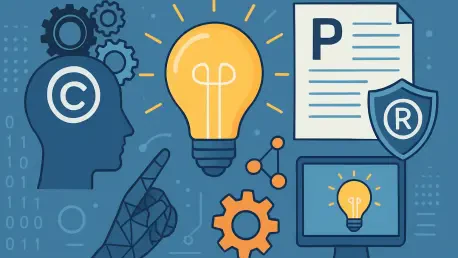In a world where groundbreaking ideas can redefine entire industries overnight, the United States stands tall as a beacon of innovation, largely due to the robust framework of intellectual property (IP) protections that safeguard creativity. From the development of life-altering medical treatments to the creation of cutting-edge technologies that shape daily life, IP rights have long been the silent engine driving American ingenuity forward. These protections not only reward creators for their bold risks but also ensure that society benefits from a continuous cycle of progress. As global competition intensifies, understanding the role of IP becomes more critical than ever. It’s not merely a legal construct but a vital pillar that upholds the nation’s economic strength, fosters job creation, and maintains a competitive edge on the world stage. This exploration delves into the historical, economic, and societal dimensions of IP, revealing why safeguarding these rights remains essential for sustaining America’s position as a leader in innovation.
Historical Foundations of American Innovation
The roots of intellectual property in the United States trace back to the very inception of the nation, reflecting a profound understanding of its importance by the Founding Fathers. Figures like George Washington and James Madison championed the idea that protecting creators’ rights was crucial for advancing “the progress of science and useful arts.” By embedding IP safeguards in the U.S. Constitution, they crafted a visionary system that grants inventors and artists exclusive rights for a limited period. This mechanism not only incentivizes individual creativity but also ensures that, over time, innovations enter the public domain, enriching society as a whole. This delicate balance between personal gain and communal benefit has been a cornerstone of American progress, fostering an environment where new ideas are not just born but are nurtured to transform lives and industries across generations.
Beyond its constitutional origins, the historical significance of IP lies in how it has shaped a national ethos of innovation over centuries. Early American inventors, protected by these rights, laid the groundwork for transformative advancements, from the cotton gin to the telegraph, each building on the last to propel the country forward. This legacy demonstrates that IP is not a modern invention but a timeless principle that has consistently rewarded risk-taking and perseverance. The foresight of the nation’s founders in prioritizing IP created a ripple effect, establishing a culture where creativity is both a personal pursuit and a public good. Today, this historical framework continues to inspire policies and practices that protect intellectual contributions, ensuring that the spirit of innovation remains deeply ingrained in the American identity, driving progress in an increasingly complex global landscape.
Economic Backbone of a Creative Nation
Intellectual property serves as a powerhouse for the U.S. economy, with staggering figures underscoring its impact on growth and stability. Data reveals that IP-intensive industries contributed $7.8 trillion to the GDP in 2019, accounting for 41% of the total economic output, while supporting 63 million jobs—nearly 44% of national employment. Additionally, a $74 billion IP trade surplus in 2022 highlights the global value of American creativity. Workers in these sectors often enjoy wages 60% higher than those in non-IP fields, frequently accompanied by superior benefits such as comprehensive health coverage and retirement security. These statistics paint a clear picture: IP doesn’t merely generate wealth; it fortifies the financial well-being of families and sustains a thriving middle class, cementing its role as a linchpin of economic prosperity.
The economic influence of IP extends beyond raw numbers, shaping industries that define modern life and fuel upward mobility. Sectors like technology, pharmaceuticals, and entertainment thrive under the shield of IP protections, enabling companies to invest heavily in research and development without fear of immediate imitation. This security fosters an environment where bold ideas can flourish into marketable solutions, driving innovation cycles that benefit consumers and businesses alike. Moreover, the higher earnings in IP-driven fields contribute to stronger local economies, as disposable income circulates through communities, supporting small businesses and public services. The ripple effect of IP’s economic contributions underscores its importance not just as a driver of national wealth but as a foundation for equitable growth, ensuring that the benefits of innovation reach far beyond corporate boardrooms to touch everyday lives.
Regional Dynamism Through IP Protections
At the state level, intellectual property acts as a catalyst for regional economic vitality, with certain areas showcasing remarkable success due to strong IP frameworks. States like Utah and Washington consistently exceed the national average for IP-related employment, creating hubs of creativity and technical expertise that attract top talent and investment. Meanwhile, Texas stands out with over $32 billion in IP-connected exports, demonstrating how protecting intellectual assets can translate into significant trade advantages. These examples illustrate that IP rights are not just a federal concern but a local engine of growth, fostering environments where businesses feel confident to innovate, hire, and expand, thereby contributing to the broader national economy.
The regional benefits of IP protections also highlight their role in building diverse, resilient ecosystems that adapt to global challenges. In states with robust IP policies, there’s a noticeable clustering of startups, research institutions, and established firms, all collaborating under the assurance that their ideas are safe from theft or exploitation. This synergy drives technological breakthroughs and cultural advancements, positioning these regions as leaders in their respective fields. Furthermore, the economic activity spurred by IP attracts infrastructure investments, from better schools to improved transportation, enhancing quality of life for residents. By safeguarding intellectual contributions, states not only boost their own prosperity but also reinforce the interconnected web of innovation that defines America’s competitive strength, proving that IP’s impact is as local as it is national.
Challenges Undermining Creative Progress
Despite the undeniable benefits of intellectual property, the system faces persistent threats that jeopardize its integrity and the innovation it supports. Counterfeiting and IP theft, costing the global economy an estimated $467 billion in 2021, represent a significant challenge, draining financial resources and undermining trust in markets. These illicit activities extend beyond mere economic loss, posing risks to public health through counterfeit pharmaceuticals and damaging corporate reputations with substandard knockoffs. The scale of this issue reveals a darker side to globalization, where unprotected ideas can be exploited, discouraging inventors from pursuing groundbreaking work and stunting the very progress IP aims to foster.
Addressing these threats requires a deeper understanding of their multifaceted impact on both creators and consumers. Beyond the immediate financial toll, IP theft erodes job security in innovation-driven sectors, as companies lose revenue needed to sustain their workforce. Additionally, the proliferation of counterfeit goods often deceives consumers, who may unknowingly purchase unsafe or ineffective products, further compounding the societal harm. The chilling effect on innovation is perhaps the most concerning outcome, as fear of exploitation can deter small enterprises and individual inventors from bringing their ideas to fruition. Tackling this issue demands not only stronger enforcement but also greater public awareness of the stakes involved, ensuring that the environment for creativity remains secure and conducive to risk-taking in an increasingly interconnected world.
Leveling the Field for All Innovators
Intellectual property protections play a crucial role in democratizing innovation, ensuring that not just large corporations but also small and medium-sized enterprises can thrive. Through mechanisms like patents, trademarks, and copyrights, smaller players gain the legal backing to protect their ideas, giving them the confidence to compete on a global stage. This empowerment is vital in a landscape often dominated by industry giants, as it allows startups and independent creators to turn visionary concepts into tangible products without immediate fear of replication. The result is a more vibrant, diverse market where innovation isn’t monopolized but shared across countless contributors.
This leveling effect of IP also fosters a culture of entrepreneurship that is uniquely American, encouraging individuals from varied backgrounds to pursue their dreams. For every major tech firm, there are countless smaller entities leveraging IP rights to carve out niches in fields like sustainable energy, health tech, and digital media. These protections ensure that innovation remains accessible, providing a shield against unfair competition and enabling underdogs to secure funding and partnerships. By safeguarding the intellectual contributions of all, IP nurtures a competitive ecosystem where the next transformative idea could emerge from anywhere—a garage, a university lab, or a rural workshop—amplifying the nation’s overall creative output and reinforcing its global standing.
Building a Future of Protected Innovation
The journey to maintain America’s innovative edge through intellectual property has seen remarkable strides, with historical commitment and economic data reflecting its profound impact. Reflecting on past efforts, policymakers and industry leaders collaborated to fortify IP laws, ensuring they adapted to digital age challenges while honoring constitutional principles. State-level initiatives mirrored this dedication, creating localized success stories that bolstered national prosperity. Campaigns during Intellectual Property Month in October heightened awareness, reminding stakeholders of the persistent threats like counterfeiting that once loomed large but were met with determined enforcement.
Looking ahead, the focus must shift to proactive strategies that anticipate future risks while sustaining an environment ripe for creativity. Strengthening international cooperation to combat IP theft, investing in educational programs to inform emerging innovators about their rights, and refining policies to address technological advancements are essential steps. By committing to these actions, the foundation laid by past vigilance can be built upon, ensuring that the U.S. continues to be a cradle for groundbreaking ideas. The path forward lies in balancing protection with accessibility, so that every creator, regardless of scale, can contribute to a legacy of innovation that defines American strength.









